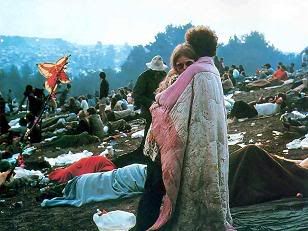At some point or another, people of my generation have heard about Woodstock. Many of us don’t know the full works of the festival but just the obvious fact: Woodstock was a wild concert that young people of the sixties and hippies attended and experienced events unimaginable.
The largest gathering of the counterculture was Woodstock. The hippies had gathered for “be-ins” in San Francisco’s Golden Gate Park, attended outdoor rock festivals, and other free music venues, but nothing could compare to the concert of August 15, 1969. Woodstock was a three day event held on a farm in rural New York. A large crowd was expected to show for several days of music, but when as many as 400,000 people flooded the area, everything went haywire. People were jumping over fences, abandoned cars filled the highway and the rain seemed endless.

But officials weren’t dealing with raging, belligerent people. The festival goers were peaceful, shared everything to anyone who needed it, were harmonious. The police even spoke well of the fans. The people had a precise objective of the festival; to be in a setting were their values prevailed. Drugs, nudity, and sex were a few highlights of the three-day festival.
The music that was heard at Woodstock could never be repeated. Some of the most famous musicians and rock bands played for the animated young crowd. The musicians had to be air-lifted in on helicopters because traffic was backed up for miles. Fans from all over the country heard, The Who, Jefferson Airplane, Santana, Janis Joplin, Country Joe and the Fish, Crosby, Stills & Nash, and many others including Jimi Hendrix; who closed the festival with a psychedelic, rock version of the national anthem.
Woodstock is known today as one of the most peaceful large events ever, as well as, the greatest and most famous festival of all time. The conditions were tough. I think that if you weren’t a free-spirited hippie you would have been toast. For three nights the people slept on top of mud, either in a wet sleeping bag or nothing. Food was scarce and the unsanitary conditions were frightening. Yet none of this put the slightest damper on the meaning of the festival. There was a genuine atmosphere of sharing and friendship, and though they were cold and hungry, they found the hardships exhilarating.

During the event and the days after, the media was exclaiming Woodstock was a war zone. One local newspaper headlined the event as, “The Biggest Drug and Sex Orgy Since The Roman Empire.” Through the assumptions of reporters, the festival was deemed atrocious; until the people who attended spoke out. “You heard the wonder in their voices, saw it in their eyes, as they said, ‘We were all their together. It was beautiful.’” The celebrants called themselves, “The Woodstock Nation.”


